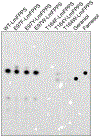Identifying Structural Determinants of Product Specificity in Leishmania major Farnesyl Diphosphate Synthase
- PMID: 32584028
- PMCID: PMC8049779
- DOI: 10.1021/acs.biochem.0c00432
Identifying Structural Determinants of Product Specificity in Leishmania major Farnesyl Diphosphate Synthase
Abstract
Farnesyl diphosphate synthase (FPPS) is an isoprenoid chain elongation enzyme that catalyzes the sequential condensation of dimethylallyl diphosphate (C5) with isopentenyl diphosphate (IPP; C5) and the resulting geranyl diphosphate (GPP; C10) with another molecule of IPP, eventually producing farnesyl diphosphate (FPP; C15), which is a precursor for the biosynthesis of a vast majority of isoprenoids. Previous studies of FPPS have highlighted the importance of the structure around the hydrophobic chain elongation path in determining product specificity. To investigate what structural features define the final chain length of the product in FPPS from Leishmania major, we designed and expressed six mutants of LmFPPS by replacing small amino acids around the binding pocket with bulky residues. Using enzymatic assays, binding kinetics, and crystallographic studies, we analyzed the effects of these mutations on the activity and product specificity of FPPS. Our results revealed that replacement of Thr-164 with tryptophan and phenylalanine completely abolished the activity of FPPS. Intriguingly, the T164Y substitution displayed dual product specificity and produced a mixture GPP and FPP as final products, with an activity for FPP synthesis that was lower than that of the wild-type enzyme. These data indicate that Thr-164 is a potential regulator of product specificity.
Conflict of interest statement
Figures







Similar articles
-
Increasing the intracellular isoprenoid pool in Saccharomyces cerevisiae by structural fine-tuning of a bifunctional farnesyl diphosphate synthase.FEMS Yeast Res. 2017 Jun 1;17(4). doi: 10.1093/femsyr/fox032. FEMS Yeast Res. 2017. PMID: 28854674
-
Farnesyl diphosphate synthase: the art of compromise between substrate selectivity and stereoselectivity.J Am Chem Soc. 2006 Dec 13;128(49):15819-23. doi: 10.1021/ja065573b. J Am Chem Soc. 2006. PMID: 17147392 Free PMC article.
-
Two Eucommia farnesyl diphosphate synthases exhibit distinct enzymatic properties leading to end product preferences.Biochimie. 2017 Aug;139:95-106. doi: 10.1016/j.biochi.2017.05.001. Epub 2017 May 3. Biochimie. 2017. PMID: 28478108
-
Approaches for Designing new Potent Inhibitors of Farnesyl Pyrophosphate Synthase.Expert Opin Drug Discov. 2016;11(3):307-20. doi: 10.1517/17460441.2016.1143814. Epub 2016 Feb 15. Expert Opin Drug Discov. 2016. PMID: 26781029 Review.
-
Structures, mechanisms and inhibitors of undecaprenyl diphosphate synthase: a cis-prenyltransferase for bacterial peptidoglycan biosynthesis.Bioorg Chem. 2012 Aug;43:51-7. doi: 10.1016/j.bioorg.2011.09.004. Epub 2011 Sep 21. Bioorg Chem. 2012. PMID: 21993493 Review.
Cited by
-
Critical Insight into Plausible Acquired Tocopherol Pathway in Neglected Human Trypanosomatids.ACS Omega. 2021 Nov 16;6(47):31396-31403. doi: 10.1021/acsomega.1c05046. eCollection 2021 Nov 30. ACS Omega. 2021. PMID: 34869966 Free PMC article. Review.
References
-
- Hunter WN (2007) The non-mevalonate pathway of isoprenoid precursor biosynthesis, J Biol Chem 282, 21573–21577. - PubMed
-
- Dhar MK, Koul A, and Kaul S (2013) Farnesyl pyrophosphate synthase: a key enzyme in isoprenoid biosynthetic pathway and potential molecular target for drug development, N Biotechnol 30, 114–123. - PubMed
-
- Kellogg BA, and Poulter CD (1997) Chain elongation in the isoprenoid biosynthetic pathway, Curr Opin Chem Biol 1, 570–578. - PubMed
Publication types
MeSH terms
Substances
Grants and funding
LinkOut - more resources
Full Text Sources
Research Materials
Miscellaneous

